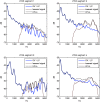Harmonic Frequency Lowering: Effects on the Perception of Music Detail and Sound Quality
- PMID: 26834122
- PMCID: PMC4737978
- DOI: 10.1177/2331216515626131
Harmonic Frequency Lowering: Effects on the Perception of Music Detail and Sound Quality
Abstract
A novel algorithm for frequency lowering in music was developed and experimentally tested in hearing-impaired listeners. Harmonic frequency lowering (HFL) combines frequency transposition and frequency compression to preserve the harmonic content of music stimuli. Listeners were asked to make judgments regarding detail and sound quality in music stimuli. Stimuli were presented under different signal processing conditions: original, low-pass filtered, HFL, and nonlinear frequency compressed. Results showed that participants reported perceiving the most detail in the HFL condition. In addition, there was no difference in sound quality across conditions.
Keywords: frequency compression; frequency lowering; frequency transposition; harmonic; hearing loss; music perception.
© The Author(s) 2016.
Figures






Similar articles
-
Nonlinear frequency compression: effects on sound quality ratings of speech and music.Trends Amplif. 2013 Mar;17(1):54-68. doi: 10.1177/1084713813480856. Trends Amplif. 2013. PMID: 23539261 Free PMC article.
-
Dynamic Range Across Music Genres and the Perception of Dynamic Compression in Hearing-Impaired Listeners.Trends Hear. 2016 Feb 10;20:2331216516630549. doi: 10.1177/2331216516630549. Trends Hear. 2016. PMID: 26868955 Free PMC article.
-
Musical sound quality impairments in cochlear implant (CI) users as a function of limited high-frequency perception.Trends Amplif. 2012 Dec;16(4):191-200. doi: 10.1177/1084713812465493. Epub 2012 Nov 19. Trends Amplif. 2012. PMID: 23172009 Free PMC article.
-
Effects of bandwidth, compression speed, and gain at high frequencies on preferences for amplified music.Trends Amplif. 2012 Sep;16(3):159-72. doi: 10.1177/1084713812465494. Epub 2012 Nov 19. Trends Amplif. 2012. PMID: 23172008 Free PMC article. Review.
-
Frequency-lowering devices for managing high-frequency hearing loss: a review.Trends Amplif. 2009 Jun;13(2):87-106. doi: 10.1177/1084713809336421. Trends Amplif. 2009. PMID: 19447764 Free PMC article. Review.
Cited by
-
Effects of Adaptive Non-linear Frequency Compression in Hearing Aids on Mandarin Speech and Sound-Quality Perception.Front Neurosci. 2021 Aug 13;15:722970. doi: 10.3389/fnins.2021.722970. eCollection 2021. Front Neurosci. 2021. PMID: 34483833 Free PMC article.
-
Evaluation of a Frequency-Lowering Algorithm for Adults With High-Frequency Hearing Loss.Trends Hear. 2017 Jan-Dec;21:2331216517734455. doi: 10.1177/2331216517734455. Trends Hear. 2017. PMID: 29027511 Free PMC article. Clinical Trial.
References
-
- Alexander, J. M. (2012). Nonlinear frequency compression: Balancing start frequency and compression ratio. Paper presented at 39th Annual Meeting of the American Auditory Society, March 8–12, Scottsdale, AZ.
-
- Alnahwi M., AlQudehy Z. A. (2015) Comparison between frequency transposition and frequency compression hearing aids. The Egyptian Journal of Otolaryngology 31(1): 10–18.
-
- Auriemmo J., Kuk F., Lau C., Marshall S., Thiele N., Pikora M., Stenger P. (2009) Effect of linear frequency transposition on speech recognition and production of school-age children. Journal of the American Academy of Audiology 20(5): 289–305. - PubMed
-
- Bachem A. (1937) Various types of absolute pitch. Journal of the Acoustical Society of America 9(2): 146–151.
Publication types
MeSH terms
LinkOut - more resources
Full Text Sources
Other Literature Sources
Medical

